Made with coconut cake layers, dulce de leche, toasted coconut, and coconut caramel buttercream, my new Coconut Caramel Cake is a delicious, melt-in-your-mouth light and fluffy cake. These two flavors are the perfect pair.
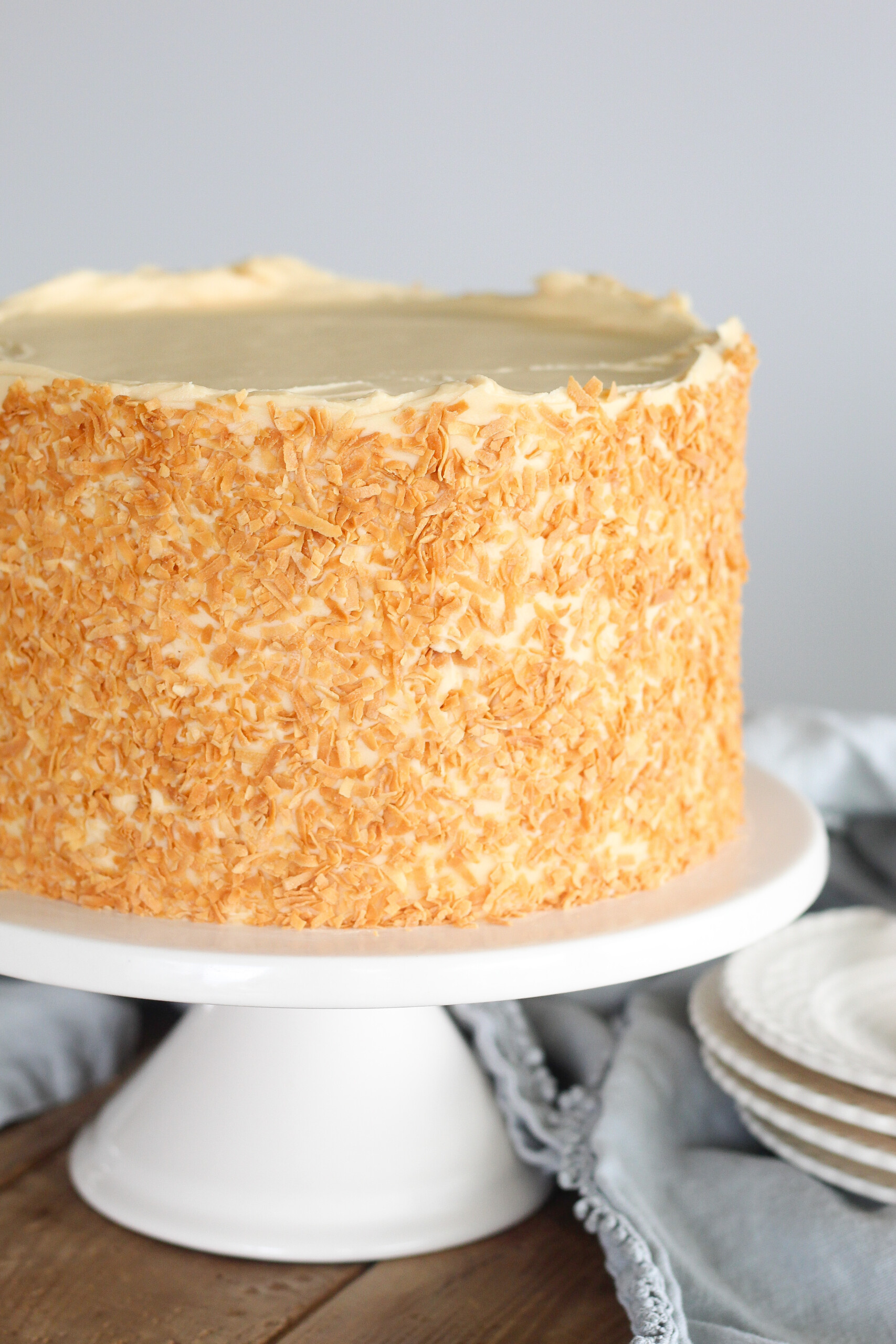
Coconut Caramel Cake
Inspired by alfajores, a traditional Latin American shortbread dulce de leche sandwich cookie, I have no doubt this Coconut Caramel Cake is going to be a new hit dessert at your house.
Tender and fluffy coconut cake layers are layered with dulce de leche, flakey salt, toasted coconut, and coconut caramel buttercream. Each bite melts in your mouth. It’s a flavor combination you don’t want to miss out on and a perfect one to end the summer with!

What is an Alfajor?
An alfajor is a type of cookie, popular in Latin America and Spain. I was first introduced to this shortbread and dulce de leche sandwich cookie by my brother, who became obsessed with alfajores while living in Paraguay for two years. With the delicate shortbread cookie and dulce de leche center, these cookies truly melt-in-your-mouth. You’ll also find them rolled in coconut flakes and covered in powdered sugar. Yum!
Chris has been requesting this flavor combination in a cake for years and I’m so excited I finally got around to it. Coconut and caramel were made for each other!

The Most Delicious Coconut Cake Recipe
If you haven’t tried this recipe, you’re in for a treat! This coconut cake is moist, flavorful, and incredibly tender.
To make sure you get the right texture, ensure you’re using cake flour and coconut cream. Make sure to read through the FAQs below to ensure you’re getting the right texture.
Frequently Asked Questions About Coconut Cake
Why is it important to use cake flour?
Cake flour is a finely milled flour with a lower protein content that other flours. The low protein content is important because lower protein means lower gluten, which results in a lighter, fluffier crumb.
Why does my cake taste dry?
If your cake is tasting dry, it’s likely one or more of the following has occured:
- You’ve over baked the cake layers – over baking the cake layers can happen within a couple minutes of baking. Because we’re using a finer flour, we have a very delicate crumb. We have to be super careful with our bake time to ensure we cook these layers at just the right time. When you insert a toothpick in the center of the cake, it should come out with a few moist crumbs on it. Remember, your cake layers continue to bake as they cool in the pans for a few minutes. It’s also smart to use an oven thermometer to ensure the oven is running at the right temperature and not too hot.
- You’ve over mixed the batter – don’t forget, when you start adding the dry ingredients to the batter, you want to mix on LOW SPEED just until the flour is incorporated. Over beating your batter can result in a dry, dense cake.
- You’re serving the cake cold – this may sound silly, but the temperature at which you serve the cake will change the texture of the cake. A cold cake often tastes dry compared to room temperature cake.
Can I use lowfat coconut milk?
To make sure we get a moist, tender cake, we want to ensure there’s enough fat to create and retain moisture. Since we’re using mostly egg whites in this recipe, we want to supplement the recipe with fat. Full-fat coconut milk gives us fat and flavor. It’s a win-win. When you open your can of coconut milk, make sure to stir the thick cream and thinner liquid together. You’ll then measure for the recipe.
How do I get my cake layers to rise well?
To ensure your cake layers rise well, make sure you check the box on the following:
- Use room temperature ingredients – using room temperature ingredients allows those wet ingredients to better blend together AND allows the dry ingredients to better absorb them. Both of these things help your cake layers to rise beautifully.
- Make sure you beat the butter, sugar, and eggs really well at the beginning. You’ll see that I’m noting in the instructions to beat these ingredients on a medium-high speed, until smooth and fluffy. You’ll notice the color gets lighter and the volume increases. That’s exactly what we’re looking for.
- Use good quality pans – the types of pans you use matter! Use light metal pans by a brand that specializes in baking pans. I always recommend Fat Daddio pans.
- Don’t over-mix your batter – once you start adding dry ingredients, you should use a low speed and only mix until your ingredients are incorporated.
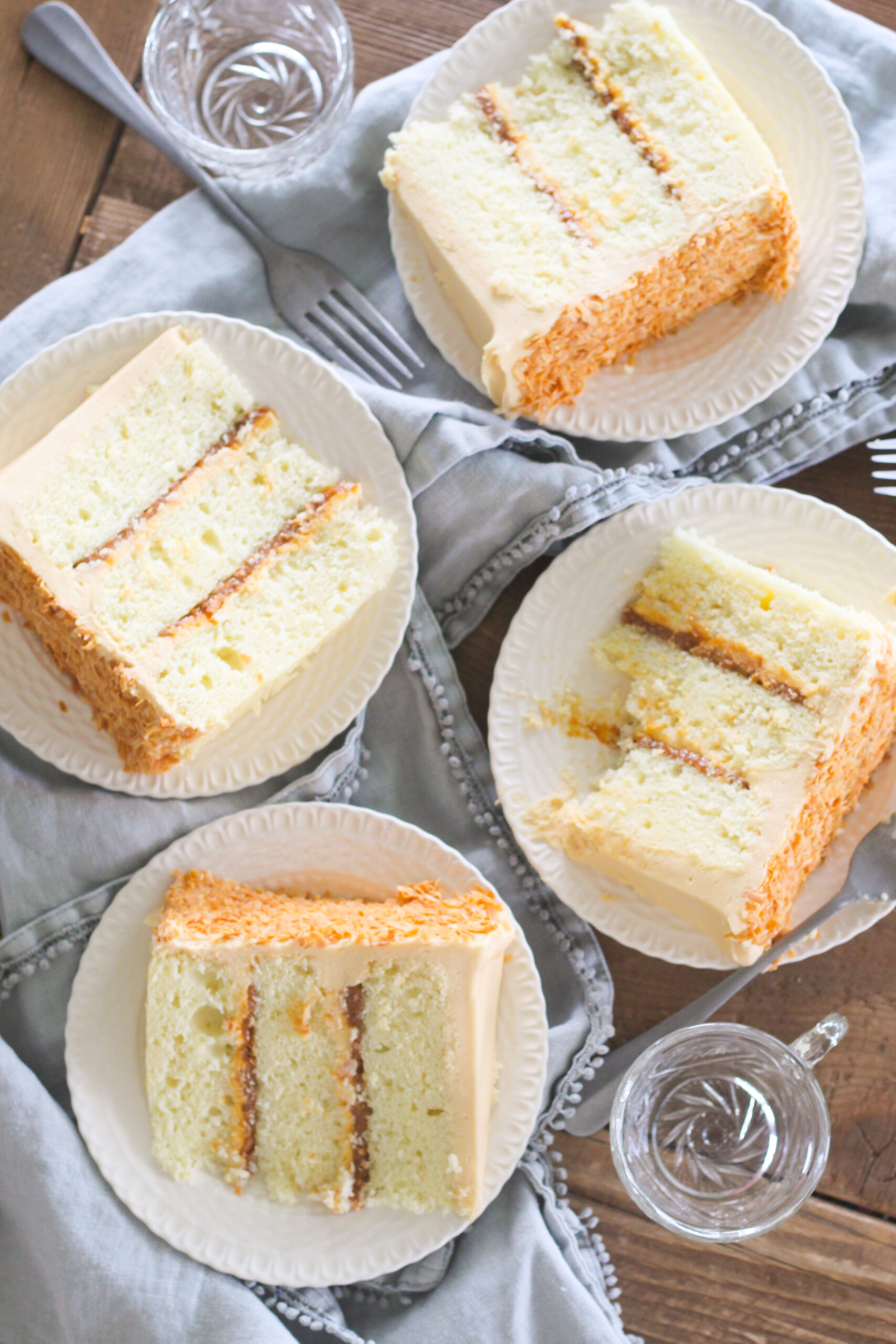
Dulce de Leche and Coconut Cake Fillings
In addition to the coconut caramel buttercream (which you’ll read more about below), we’re adding dulce de leche and toasted coconut between the layers. Something to get excited about? You can buy both of these items!
Dulce de Leche
For the dulce de leche, we’re using THIS brand, or something similar. For the buttercream and layers, one 13 ounce can is all you’ll need.
Toasted Coconut
For the toasted coconut, I actually buy this premade too! I buy mine from Orson Gygi. Since I use it for a lot of recipes, the 2.5 pound bag is totally worth buying – especially if you’re like me and tend to burn coconut when you’re toasting it on your own!
Flakey Salt
Time to talk about a secret game changer to this cake: flakey salt! I think this unexpected element really brings out the caramel flavor of the dulce de leche and is a great balance to the cake’s sweeter side. It’s totally optional, but here’s a link to the salt I like.
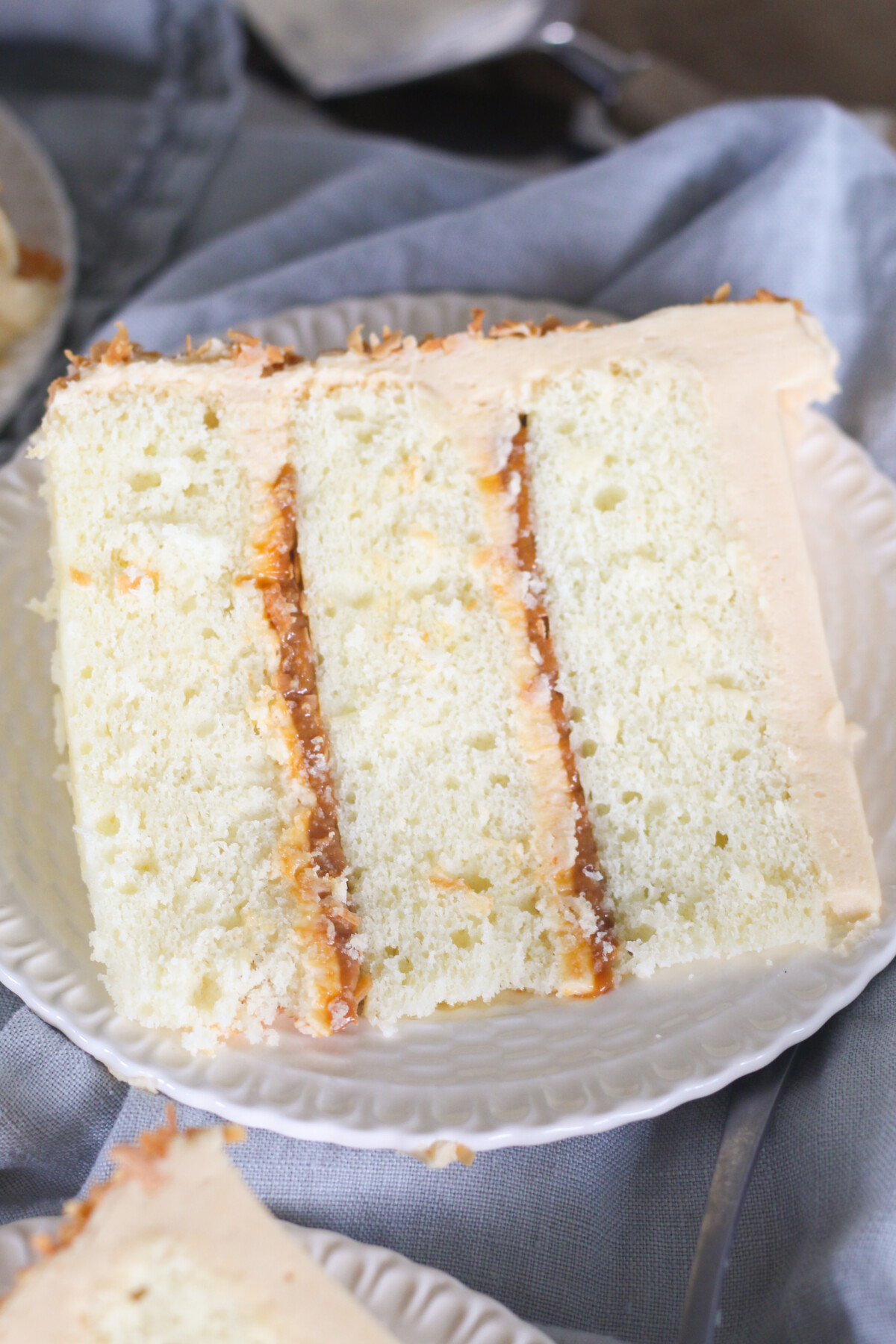
Coconut Caramel Buttercream Frosting
For the coconut and caramel buttercream, we’re using a combination of dulce de leche and coconut flavoring.
Important to note for the buttercream: we use a different type of coconut cream. This cream is actually called cream of coconut and can often be found in the alcohol aisle at the grocery store. THIS is the brand to look for.
How to Make the Best Buttercream Frosting
To get a light and fluffy, silky smooth buttercream, make sure you follow my tips: HOW TO MAKE THE BEST BUTTERCREAM
- Sift your powdered sugar
- Use slightly cold butter
- Use heavy whipping cream (we’re using coconut cream in this recipe)
- Beat for 5 minutes
- Stir by hand
You’ll want to check out the post linked above for more details on each step.
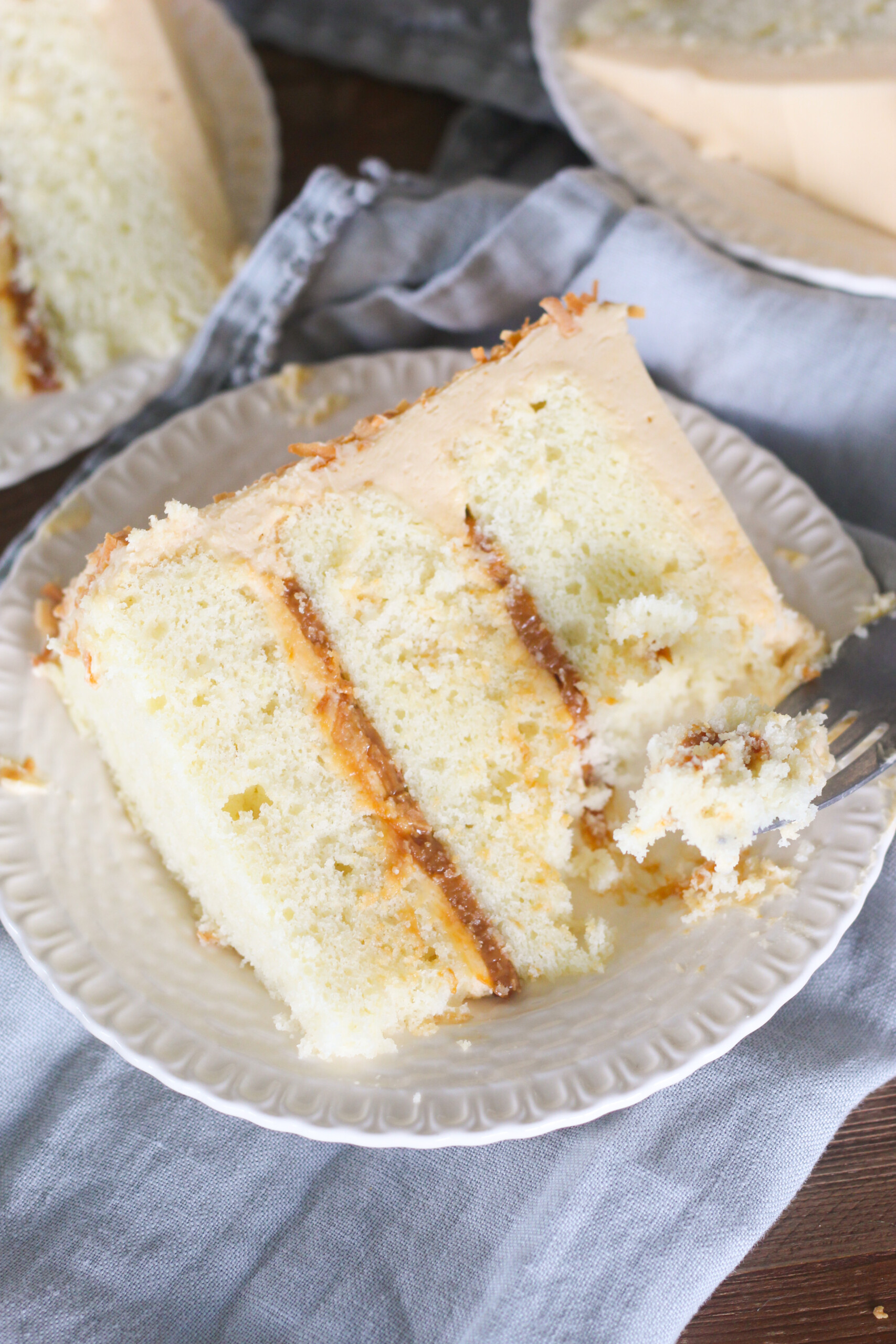
Similar Cake Recipes You’ll Love
- Coconut Key Lime Pie Cake
- Tres Leches Cake
- Pina Colada Cake
- Coconut Chocolate Cake
- Chocolate Dulce De Leche Cake
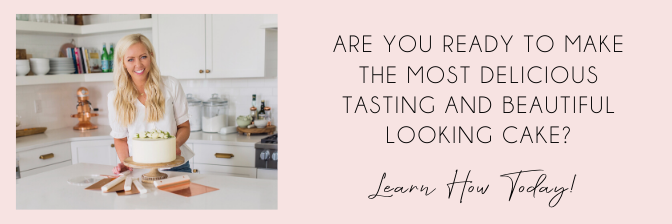

Coconut Caramel Cake
Ingredients
FOR THE CAKE
- 3 cups (345 g) cake flour
- 1 tbsp (10 g) baking powder
- 1 1/2 cups (300 g) granulated sugar
- 1 cup (226 g) unsalted butter, at room temperature
- 6 egg whites, at room temperature
- 2 whole eggs, at room temperature
- 1 tbsp (16 g) coconut emulsion
- 1 tsp (4.2 g) vanilla extract
- 1 tsp (6 g) salt
- 1 cup (231 g) canned coconut milk, the canned coconut milk usually separates, so be sure to mix the cream and the liquid really well before measuring.
FOR THE COCONUT CARAMEL BUTTERCREAM
- 2 cups (452 g) unsalted butter, slightly cold
- 1/4 cup (57.7 g) cream of coconut, this is from the bottle, not the can (linked above)
- 6 cups (750 g) powdered sugar, measured and then sifted
- 1/4 cup (80 g) dulce de leche, get one 13 ounce can of dulce de leche. You'll use the rest in the filling.
- 1/2 teaspoon (3 g) salt
- *This buttercream recipe will make enough to fill and cover your cake. If you want to add additional piping, you'll want to make an extra 1/4 to 1/2 batch
FOR THE FILLINGS
- Dulce de leche, after you've made the buttercream, split the remainder of the dulce de leche between layers
- Toasted coconut, about a cup, pre-toasted coconut linked above.
- Flakey salt, optional
Instructions
FOR THE CAKE
- Preheat your oven to 325 degrees F. Spray three 8-inch or four 6-inch pans with nonstick spray, line the bottom with parchment paper and spray again. Set aside.
- In a medium size mixing bowl, whisk the cake flour, baking powder, and salt. Set aside.
- In the bowl of a stand mixer fitted with the paddle attachment, cream the butter and the sugar together on medium-high speed for 2 to 3 minutes. The mixture should be light, fluffy, and smooth.
- Gradually add the egg whites and whole eggs, making sure to scrape down the sides and the bottom of the bowl between additions. Mix on medium-high for 2 minutes after all the eggs are added. The mixture should be smooth, light in color, and nearly doubled in volume.
- Add the coconut extract and vanilla extract.
- Turn the mixer on low speed and alternately add the flour mixture and the coconut milk, starting and ending with the flour mixture. Mix until combined. Using a spatula, scrape down the sides and bottom of the bowl and fold the batter a few times.
- Evenly distribute the batter in your pans, about 16 ounces in each 8-inch pan and about 12 ounces in each 6-inch pan.
- Bake for about 23-25 minutes, or until a toothpick inserted in the center of the cake comes out with a few moist crumbs on it. Remember, the cake continues to bake in the pan for about 5 minutes while it's cooling.
- Let cool in pans for 15 minutes and then invert onto cooling racks to cool completely.
FOR THE BUTTERCREAM
- In a stand mixer fitted with a paddle attachment, combine the butter on medium-high speed for 1 to 2 minutes, until light and fluffy.
- With the mixer on low speed, gradually add the sifted powdered sugar, followed by the salt, coconut cream, and dulce de leche.
- Turn the mixer to medium speed and beat the frosting until it is light and fluffy, about 2 to 3 minutes.
- Use a wooden spoon to stir out air bubbles.
ASSEMBLY
- Place your first cake layer, right-side up, on a cake plate or cake board. Cover the cake layer with about 1/2 cup frosting.
- Carefully spread about half of the remaining dulce de leche over the buttercream. Sprinkle with flakey salt, if using, and toasted coconut.
- Repeat step 2 for the second layer, and then place the final cake layer on top, bottom-side up.
- Lightly coat the cake with a thin layer of buttercream to lock in the crumbs. Freeze the cake for about 10 to 15 minutes to set the frosting.
- Finish frosting and decorating the cake with the remaining buttercream.
- Cover the sides of the cake with toasted coconut, if desired.

I’m confused because on the blog before the recipe, you linked unsweetened coconut cream (Thai kitchen), but later calls for full fat coconut milk. I don’t see the coconut cream listed on the actual recipe either–just cream of coconut (the bottle from the alcohol aisle that you linked as well). Can you help me with this?
Sorry for that confusion. Looks like I missed that blog note when updating the cake. Use the full fat coconut milk.
I have made so many of your cakes and they are all so delicious! I have had great success changing them to gluten free, as you suggested. Can I use gluten flour in this one? I know you recommend cake flour. Thanks for your help!
can you make this in two 9″ pans and cut the layers in half
Sure!
I embraced the recipe as it sounded delicious and coconut is one our favourite family fave ingredient. Well apart from toasted coconut for decoration and a bit inside, there is no taste of coconut. I didn’t want to use emulsifier (surely the idea of home baking is to avoid additives and artificial flavours?). It just tastes of sugar and butter and nothing else…
I will however admit that the sponge is lovely and moist, but it’s not a caramel and coconut cake…